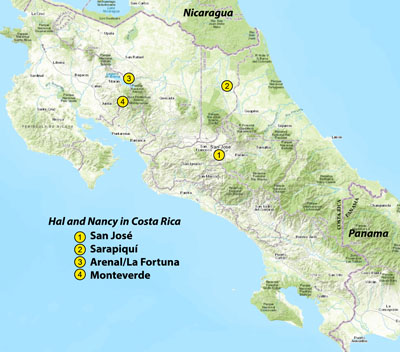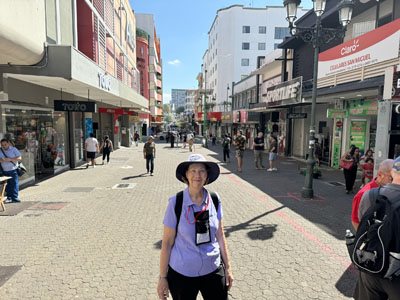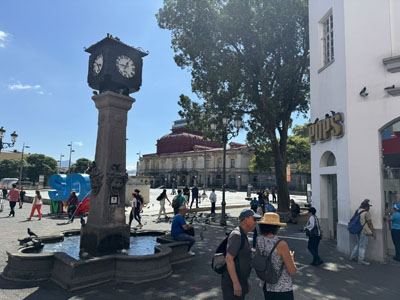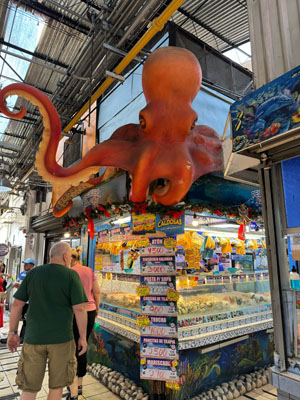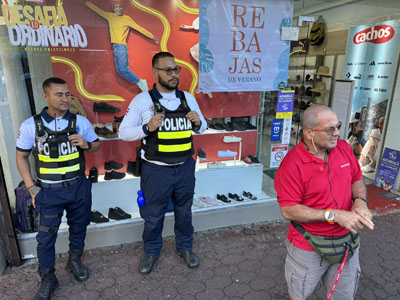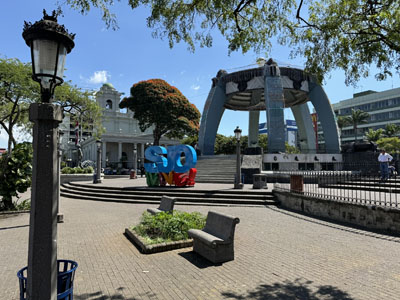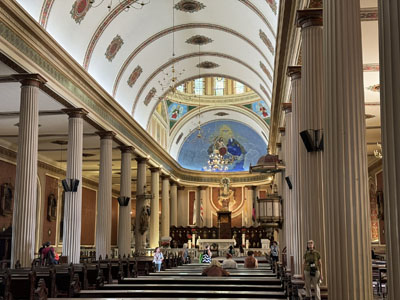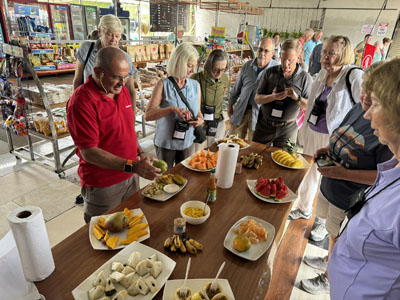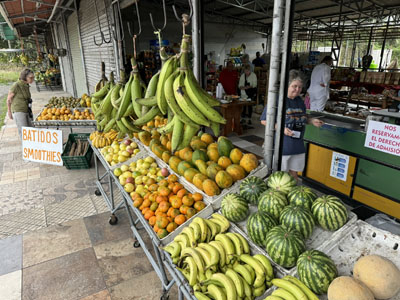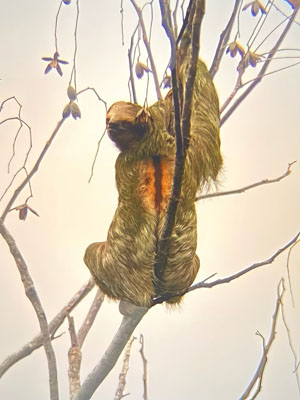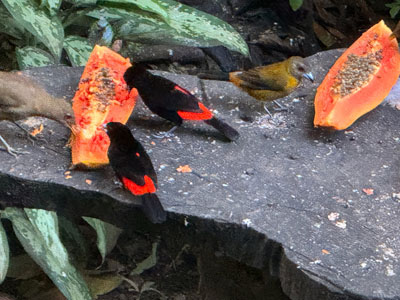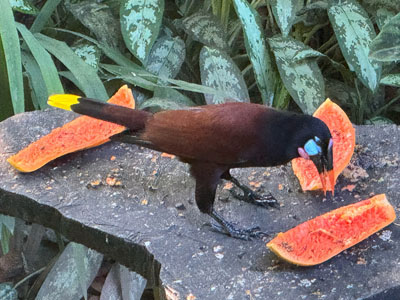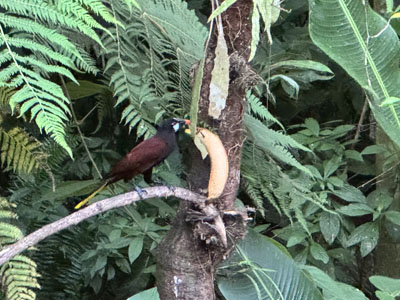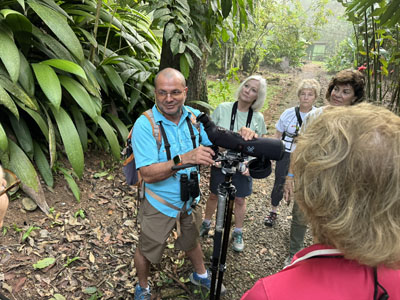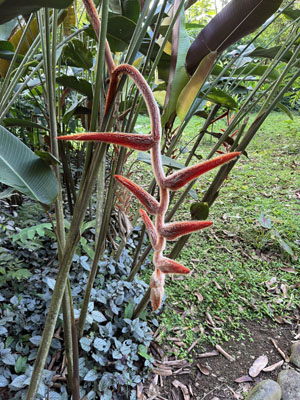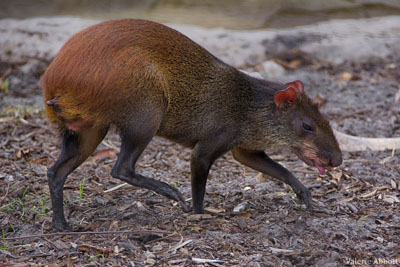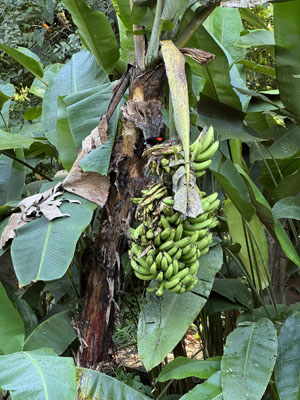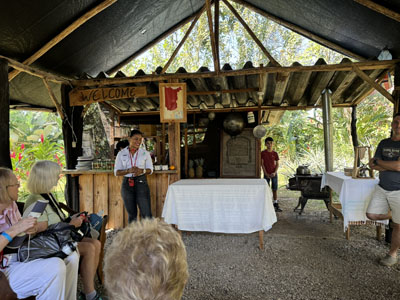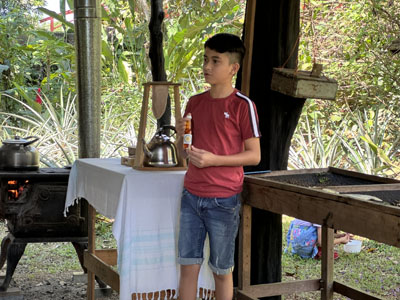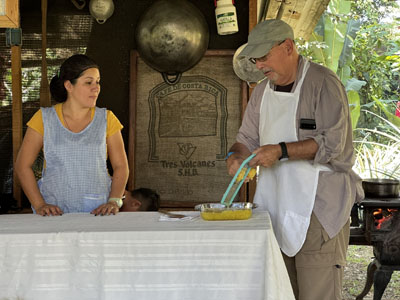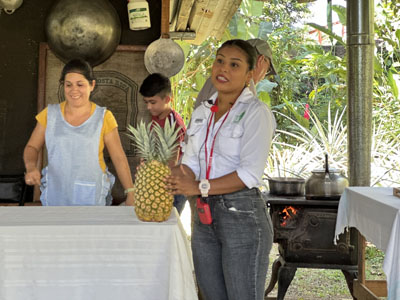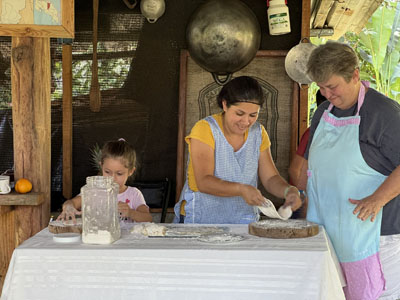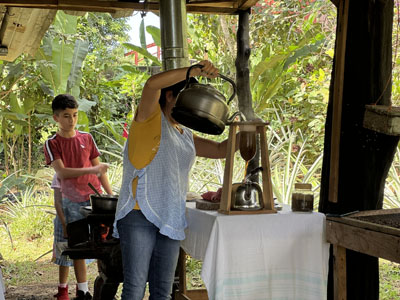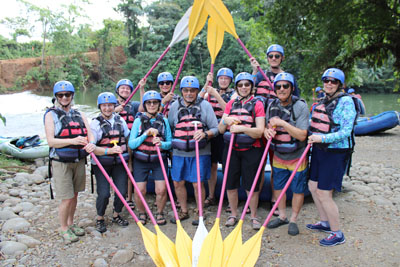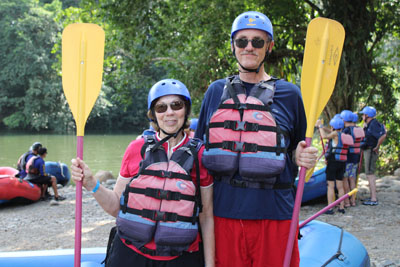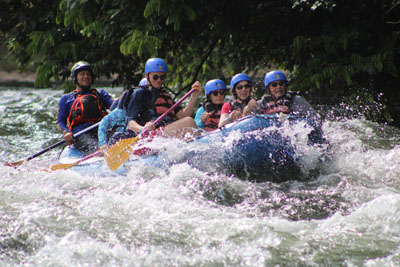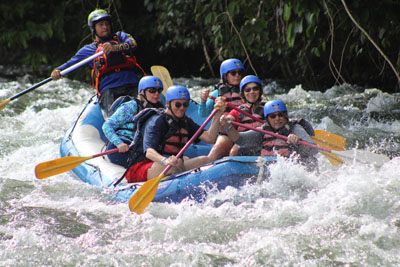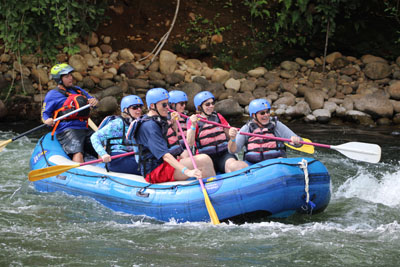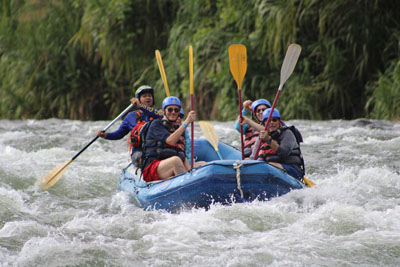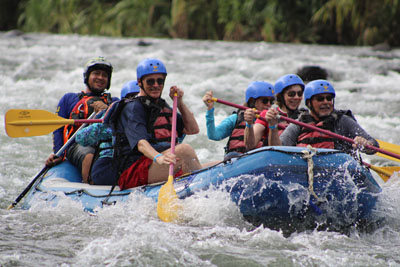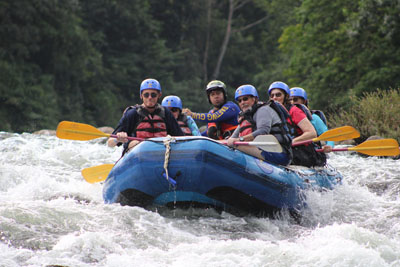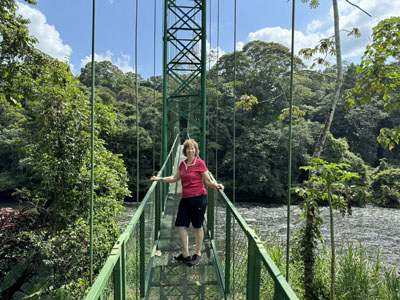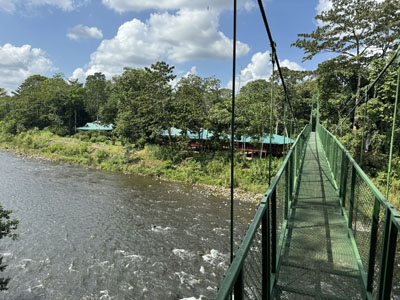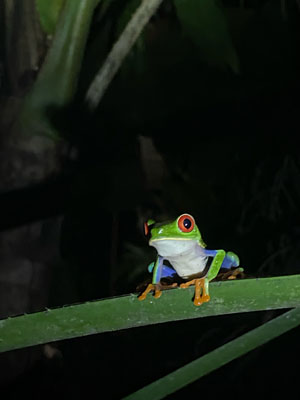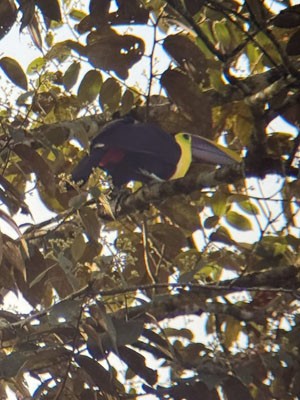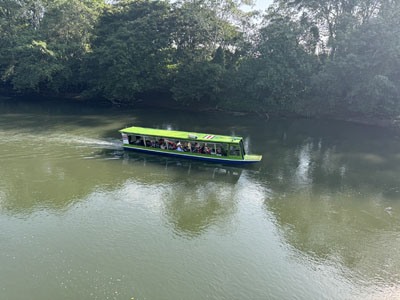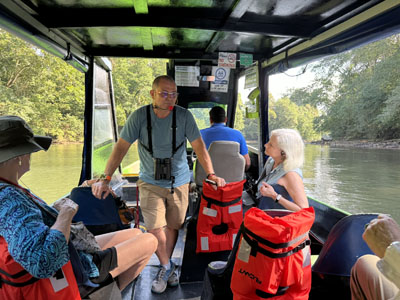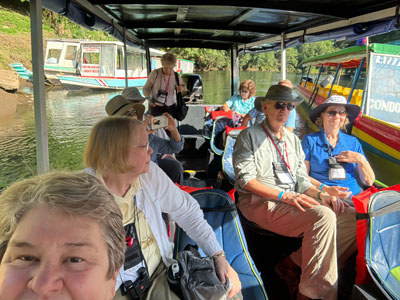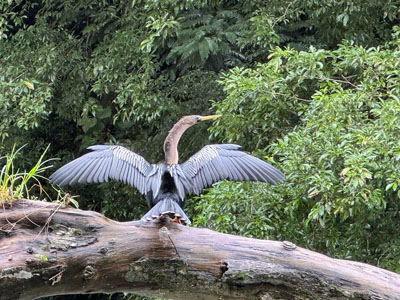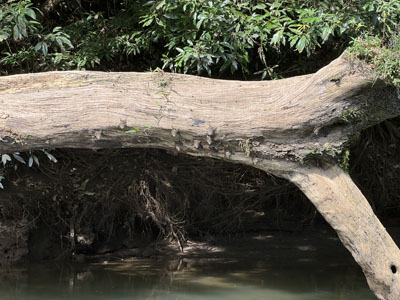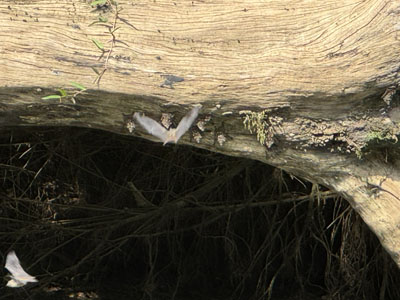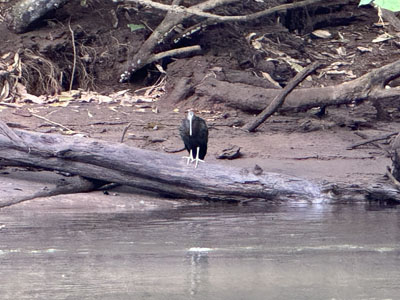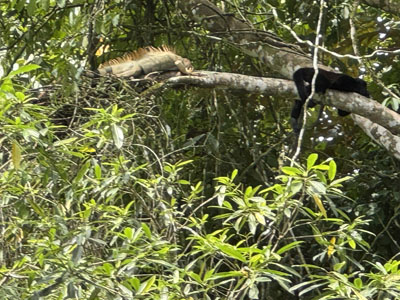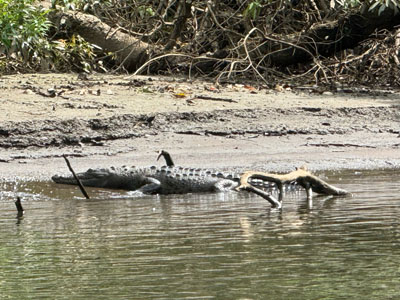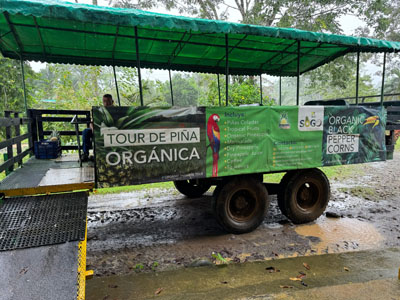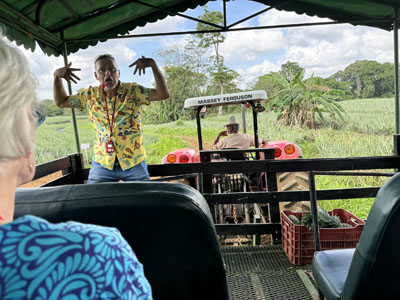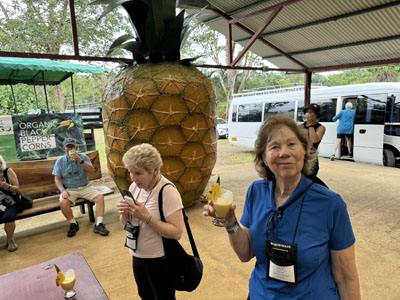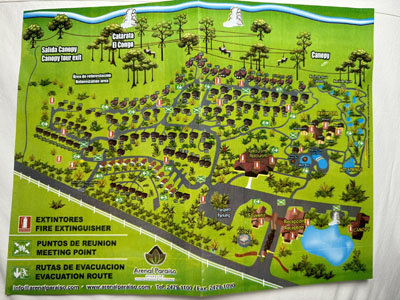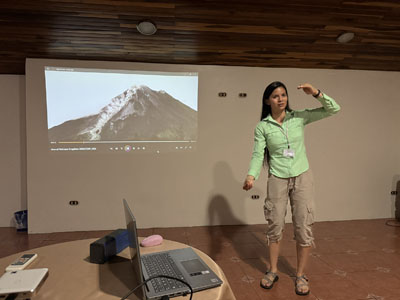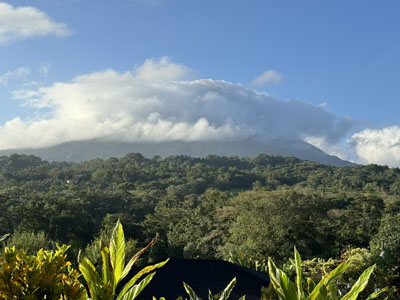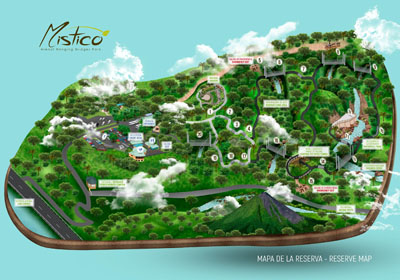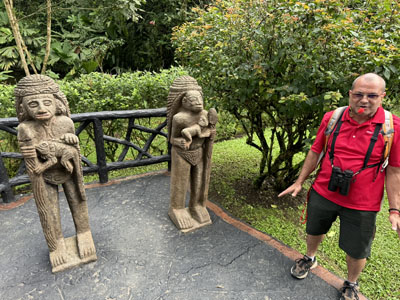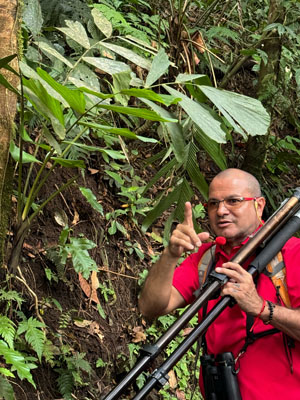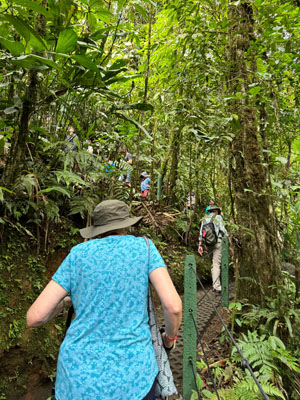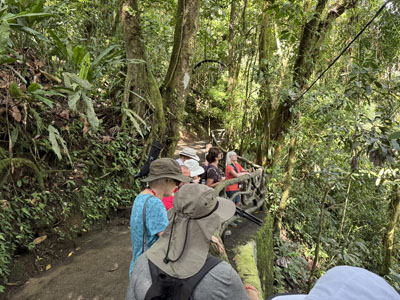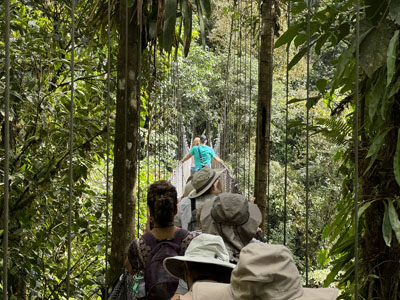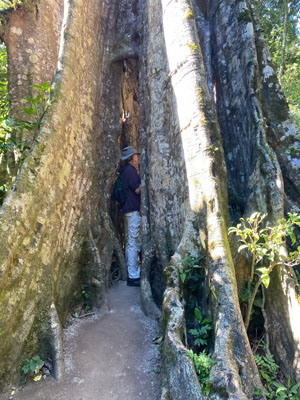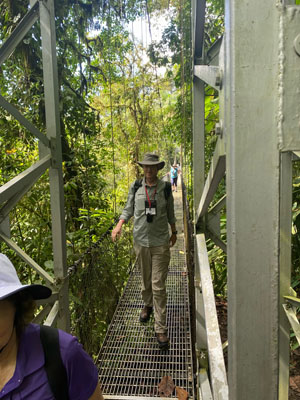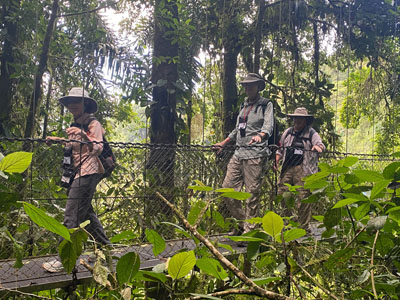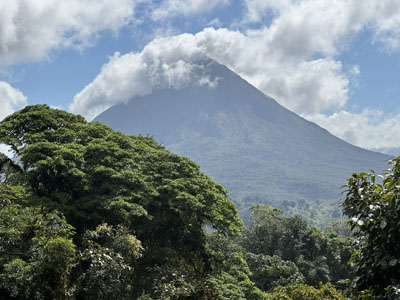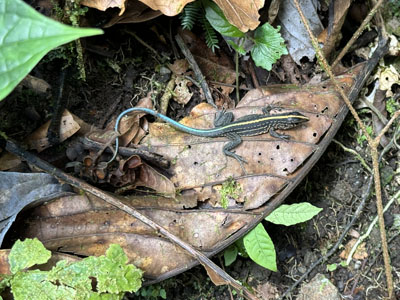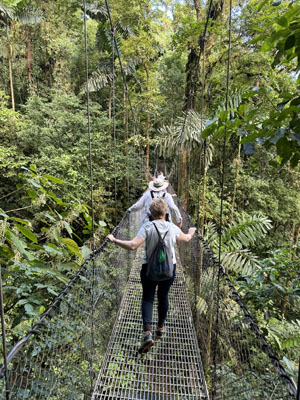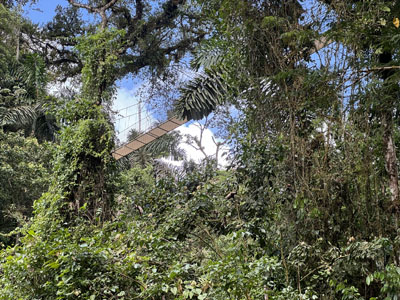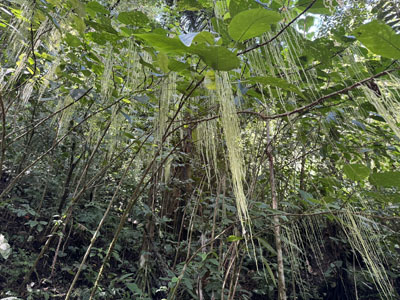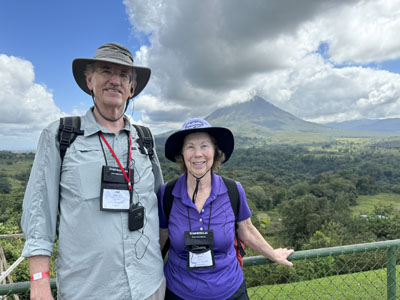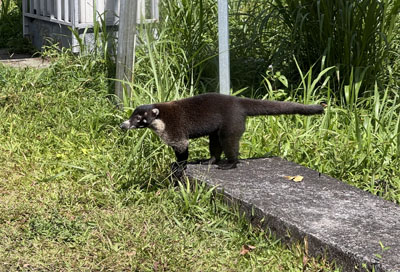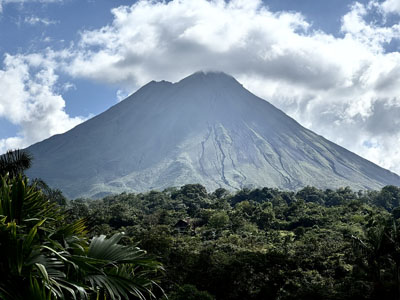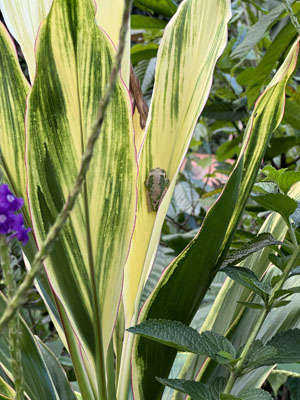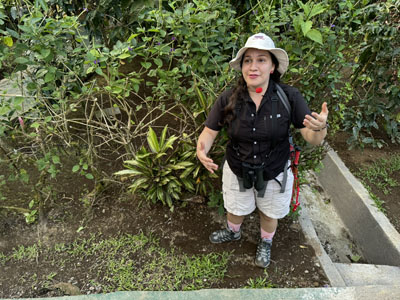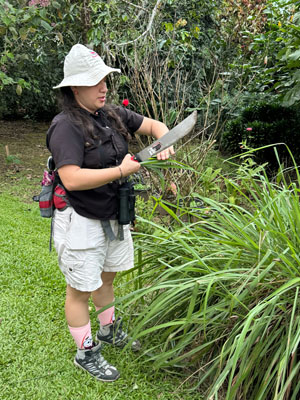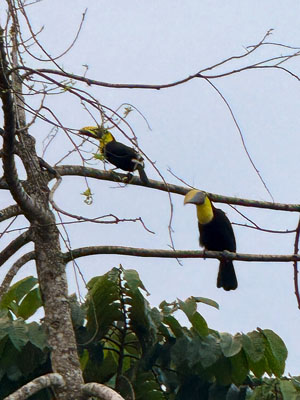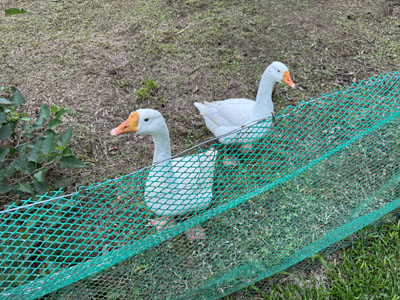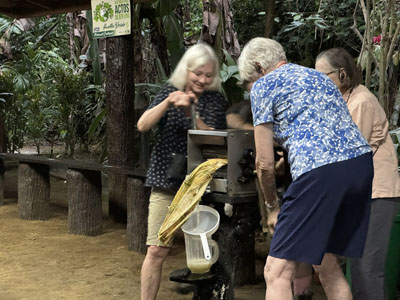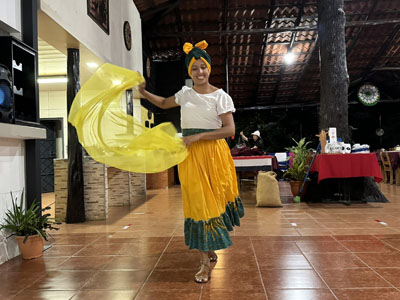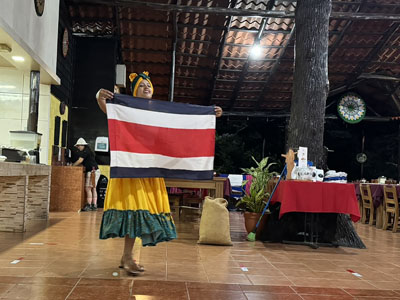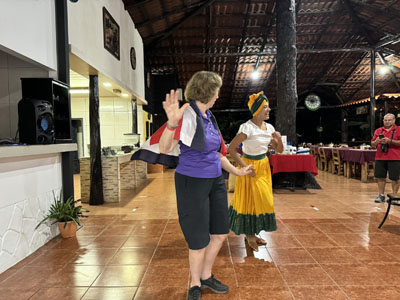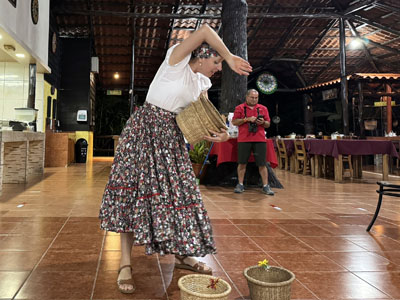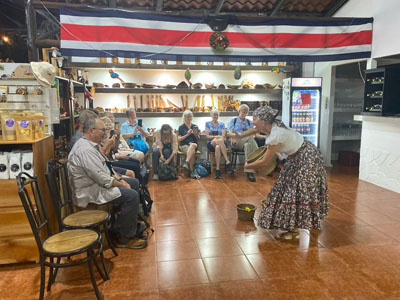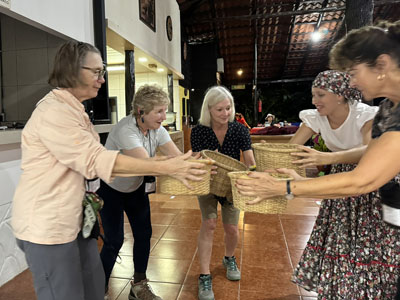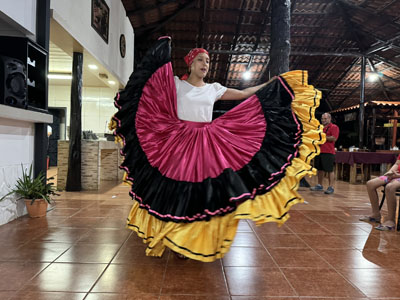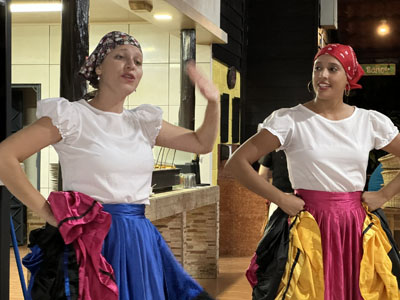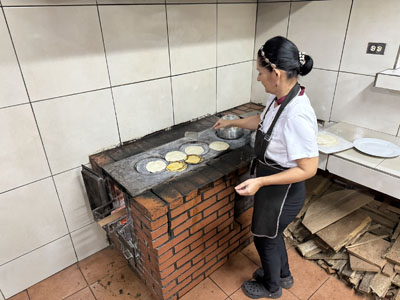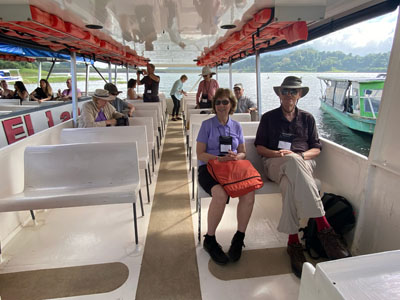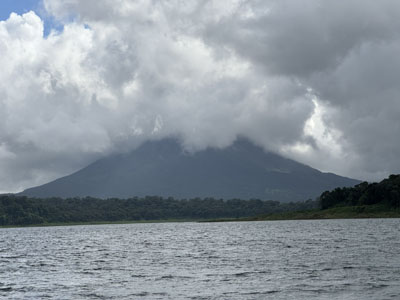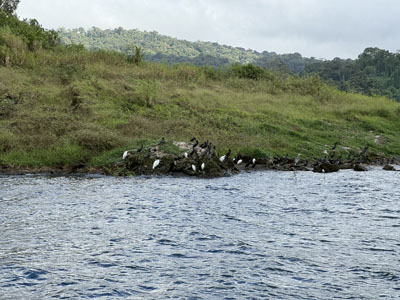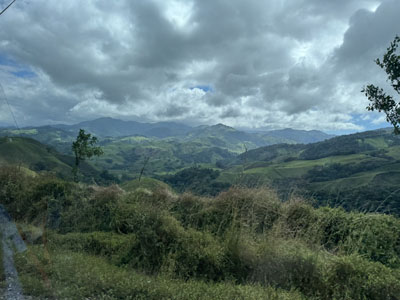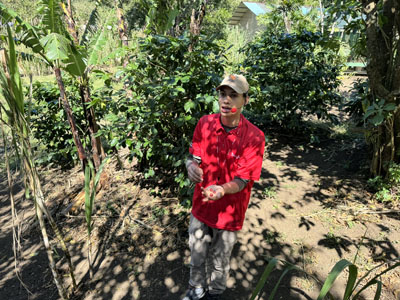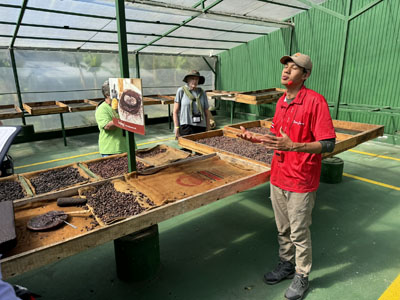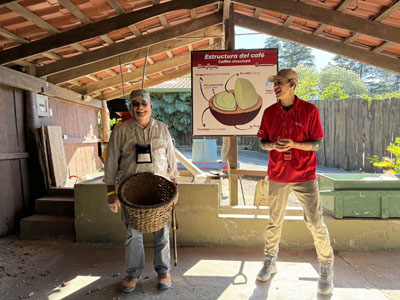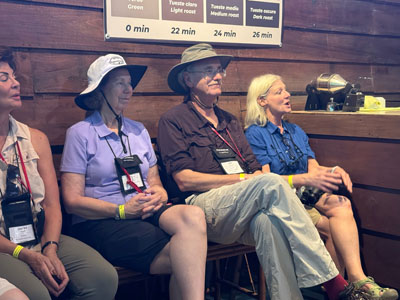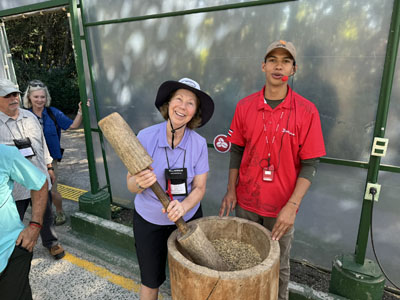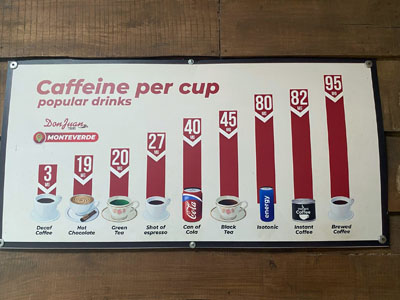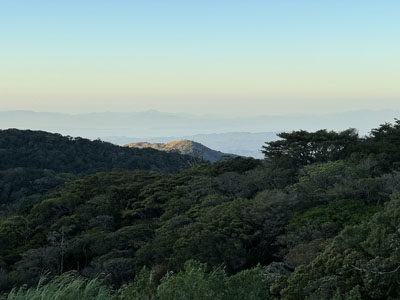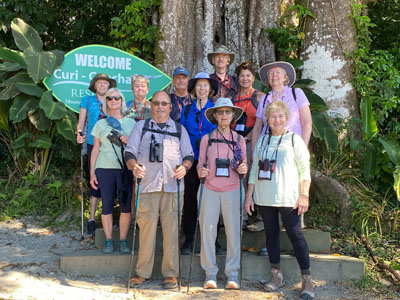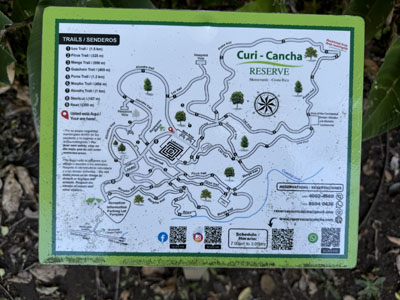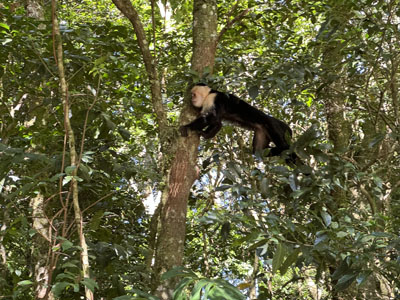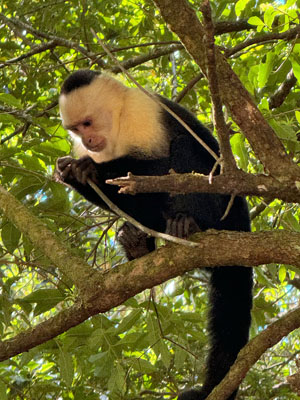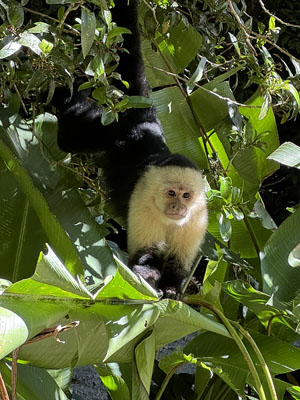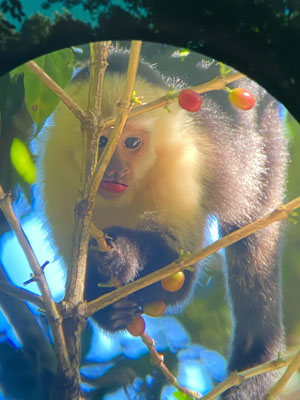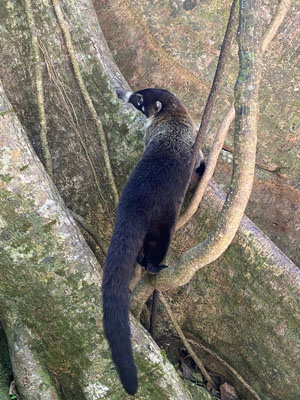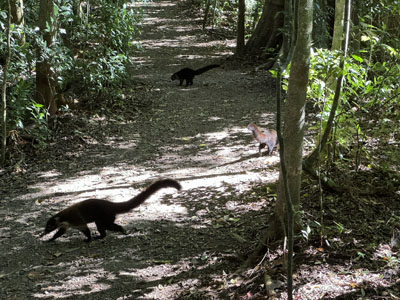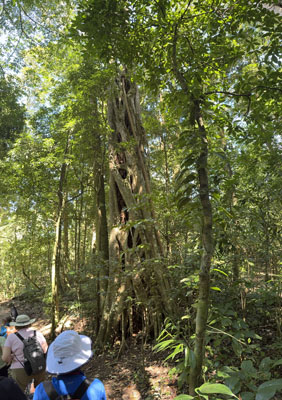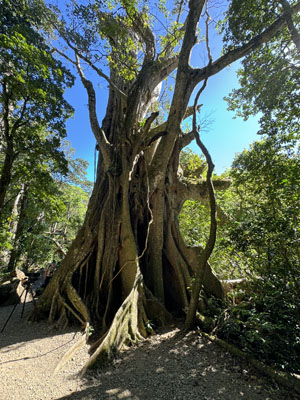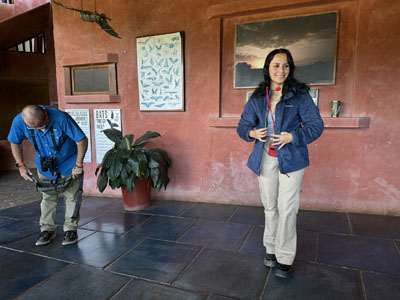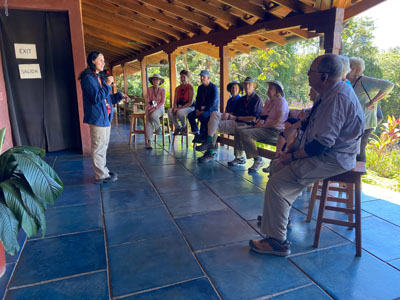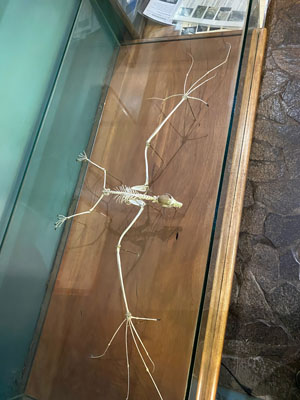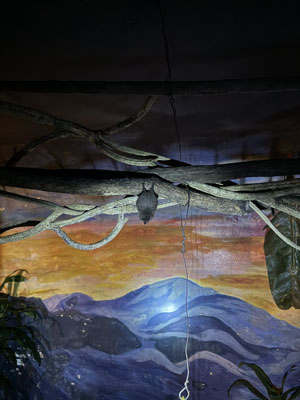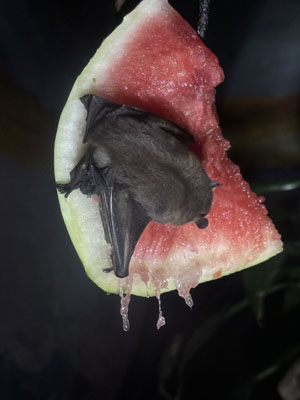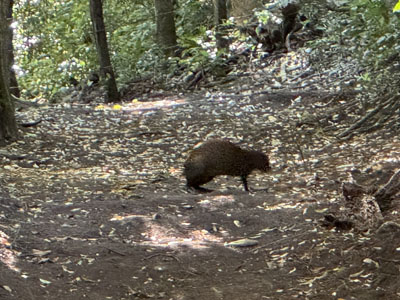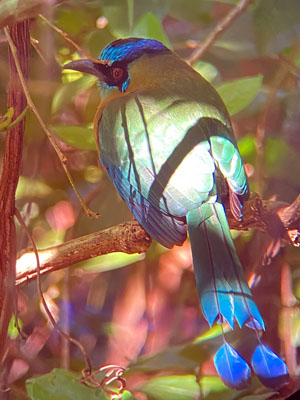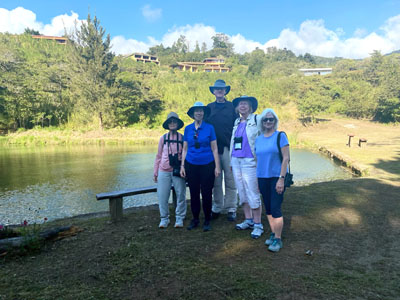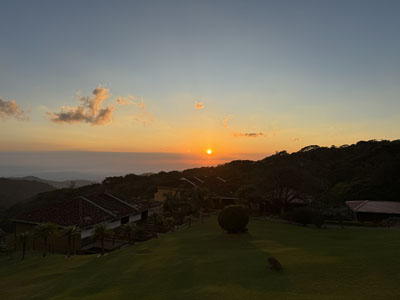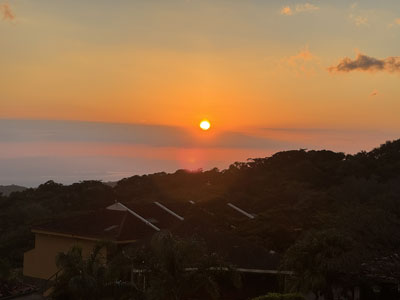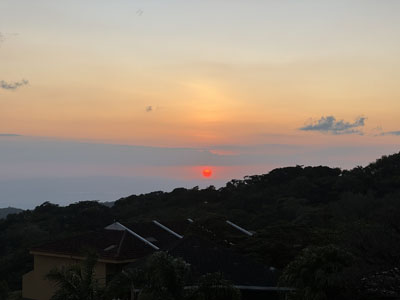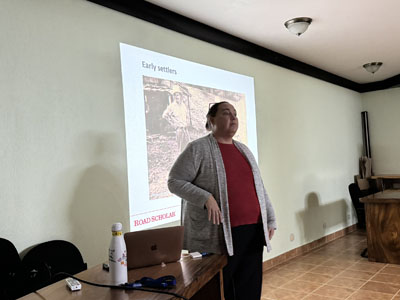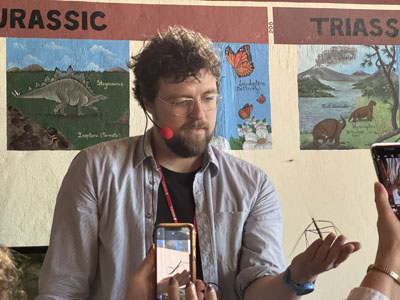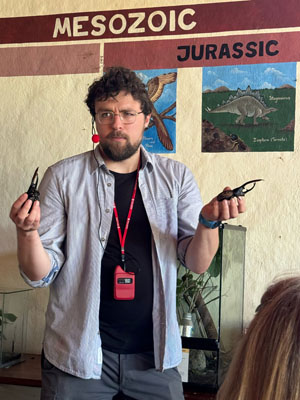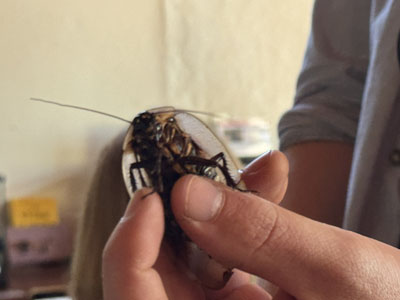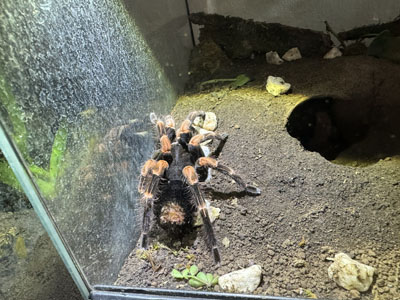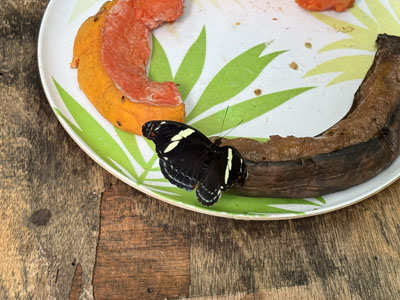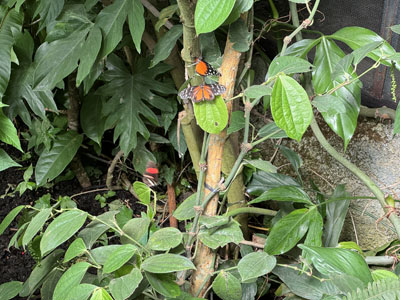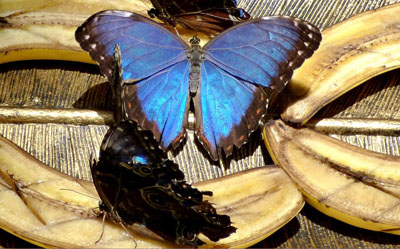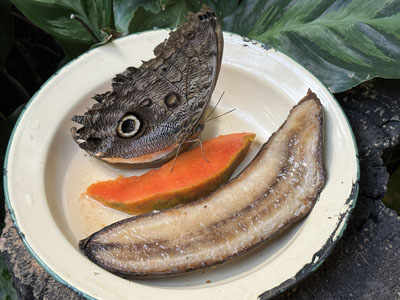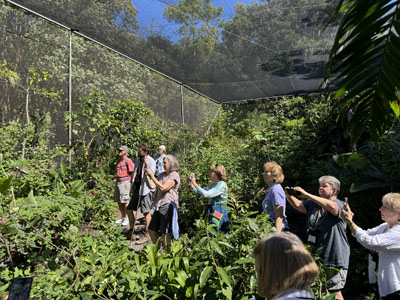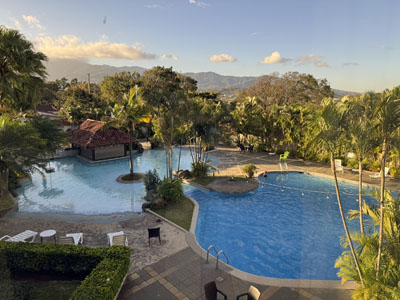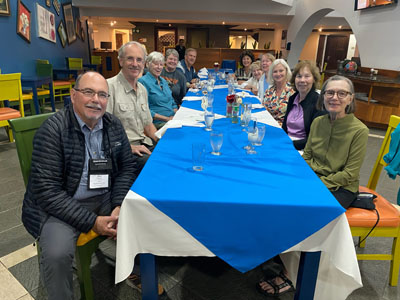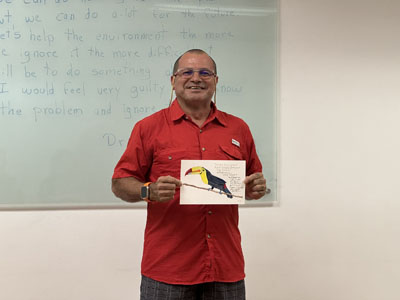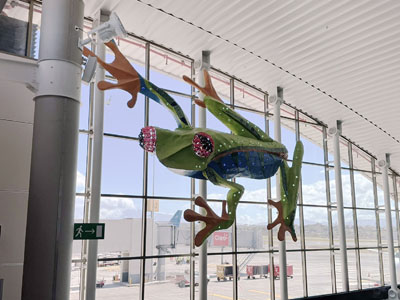Hal Jespersen’s Costa Rica Trip, January 2024
This is my (Hal’s) report on Hal and Nancy’s trip with Road Scholar, “A Taste of Costa Rica.” It is my 23rd Road Scholar educational excursion, Nancy’s 21st. Some of the photos that I have accumulated below are from our tour guide Roger, and Carol, one of the guests. I hope I have them all accurately attributed with "[ ]", but apologies if I missed one or two. The rest are from my iPhone 15 Pro.
Tuesday–Wednesday, January 9–10 — to San José
It’s not all that convenient flying from San Francisco to Costa Rica if you don’t like red-eye flights, so we flew 3.5 hours on American Airlines to Dallas Fort Worth and overnighted in the airport’s Grand Hyatt. Lots of storms around the US caused some disruptions, and our flight was 90 minutes late. Then a mid-morning AA flight to San José, another 4 hours. Costa Rica is in the US Central time zone, so no jet lag problems for us. In over 50 years of flying, this was the first time for me in which the seatbelt sign stayed on the entire flight. But there was an interesting AA feature that gave us one 20-minute session of decent WiFi for free after viewing a brief ad. Immigration control was moderately easy, although not nearly as efficient as my recent experiences in Europe. We took a taxi downtown to our group hotel. It turned out that the airport is more distant from downtown than I imagined, so with traffic it was neither fast nor inexpensive. But we had an enthusiastic driver who kept pointing out sights, without a word of English.
Our hotel is the Balmoral, which is comfortable in a modest, 1970s style. We met up for drinks with our friends Ray and Pat who have been on two previous trips with us. The group met at 6 for the usual introductory session. There are only 11 of us, which is one of the smallest groups we’ve encountered; a separate larger Road Scholar group is starting on a parallel program billed as a “slower pace.” Our guide is Roger Melendez, a local who has a lot of field wildlife monitoring experience. Dinner in the leafy hotel atrium was convivial. My first lesson about Costa Rica is to avoid hotel red house wines.
Thursday, January 11 — San José to Sarapiquí
Breakfast was in the hotel, and many of us had the “typical” Costa Rican dish, which was gallo pinto (beans and rice), eggs, and plantains. We started with an hour lecture and PowerPoint about the geography and history of Costa Rica, presented by a very affable guy named Cristian Gamboa. He covered the major geographical regions, early colonization, 19th century independence, the coffee trade, the construction of the railroad to the Caribbean Sea, the advent of the Banana Republic, the 1948 revolution, President Don Pepe, and modern society. Then we took a long walk down the Avenida Central pedestrian street and looked at various sites including the National Theater, Central Park (which was originally the starting point for the ox trains that delivered coffee beans to the Pacific coast), two big national banks, and inside the Metropolitan Cathedral (where a service with beautiful music was underway as we watched for a while). We also spent about a half hour at the Central Market, which was crowded and bustling with many dozens of stalls of all kinds.
We drove north from the city in some pretty serious traffic and stopped for lunch at El Paso restaurant, where many of us had a traditional dish called Casado—rice, beans, plantains, a salad, and one meat. Some had meat pieces like chicken or shrimp mixed in with rice, somewhat like a Chinese fried rice dish, which is called Arroz con Pollo, Gambas, etc. Then it was a long drive over the mountains down to the Caribbean rain forest. This area was for hundreds of years impenetrable jungle until the railroad opened up and the banana industry took over. We were in a small bus that had super stingy legroom, but later in the trip I found that one of the single forward seats was OK and Roger graciously announced to the group that he was reserving it for me.
We stopped at a fruit stand called Fruteria Kristal where we were presented with a large table of fresh fruit slices and a variety of candies, many coconut based. Some of the fruits were quite exotic and not available for export. On our drive we stopped abruptly to see a three-toed male sloth; Roger astonished us by spotting him a hundred feet up a tree from the moving bus. Although the sloth was quite distant, Roger had a powerful tracking scope and we were able to take photos through it. We also saw some distant toucans and macaws.
Our hotel for the next two nights is the Salva Verde Lodge and Reserve, which is a delightful eco property in dense forest on the Sarapiquí River. The rooms are in small buildings connected by covered, elevated boardwalks and ours faces the river, with a nice porch and even a hammock. We attended an informative lecture about tropical rain forests presented by a very knowledgeable woman named Yahaira Rojas. From Cristian’s lecture this morning, we saw maps in which the forested areas of the country shrank very dramatically in the 19th and particularly the 20th century, but Yahaira (who pronounces the Y in her name as J) described many of the programs the society has undertaken to turn that around. Quite a “green” country. Dinner was a buffet in the hotel, which I generally dislike, but this one was pretty decent.
Friday, January 11 — Sarapiquí
We rose early for a 6 AM bird watching hike. There is a feeding area outside the dining hall, where slices of fresh fruit are left on tables for our viewing. It’s unfortunate that iPhones are not ideal cameras for bird watching, so I took few photos. The most distinctive bird we saw was the Montezuma Oropendola, the world’s largest Oriole, with a beautiful yellow tail. There were also tanagers, toucans, and Baltimore Orioles. On a walk, we saw lots of exotic plants and a fleeting look at an agouti, the world’s second largest rodent, after the capybara. We saw some almond trees and learned how important they are for some bird species; all of the beautiful boardwalks in the resort are planked with almond, from a time in the 80s before people worried about this issue. The two animal photos below are from the internet. Then it was time for a breakfast buffet.
We drove a few miles to visit a small private farm. The family is involved with the Sarapiquí Conservation Learning Center (SCLC), which started as a library, but has expanded to teach eco-skills and other useful stuff to children of poor families. Some of us brought some school supplies to donate, others donated some dinero. Through an interpreter, we heard about the history of the area and this particular farm, which had been owned by Germans, abandoned, and then squatted upon by recent ancestors of the current family. They grow a number of crops, but the primary one seems to be peppercorns, and we heard a lengthy explanation of how both black and white peppercorns are processed from the same plant. Their little boy gave a brief speech about Mariela honey, harvested from stingless bees the size of gnats. We watched the mother demo making pineapple marmalade and arepas—with volunteer help—and the father quickly slicing up a pineapple with a machete. We had a small feast of the arepas, marmalade, and queso fresco cheese, dusted with their own pepper. And we finished with chicha de piña, a drink mildly fermented from pineapple rind and cinnamon. All yummy.
We had a free hour before lunch at the hotel, and then we suited up in swim gear for a river rafting trip on the Sarapiquí. We got a very detailed safety briefing and then set off in two rafts of six and five plus guides. We experienced seven or eight rapids, none over Class II, so they were a bit exhilarating but pretty safe. I was in the front so got rather wet. The final rapid was nicknamed the Terminator! At one point our guide maneuvered us into a ramming situation in which the rafts collided and we splashed the other crew as best we could. We saw only a sprinkling of wildlife, mostly herons and cormorants, and a dog that seemed very upset to see people having fun without him. At one point we stopped and our guide sliced up pineapple for us. At another we passed by our hotel. We had a photographer frantically paddling ahead of us in a kayak, so there were a lot of pictures available and his package was reasonable enough, so we bought it. My camera phone was packed on the bus, so all these photos are his. A great afternoon.
Back at the hotel we had a couple of hours to shower and relax. We explored a long suspension bridge over the river. Then back with the group for a Latin dance class. A lady and her son took us through the steps for three dances: merengue, salsa, and bachata. Being completely uncoordinated, I dropped out halfway through the first and we watched about eight of the others do pretty credible moves. Then dinner at the buffet again. Roger organized a night walk, but we demurred, rather tired from the day and skeptical of what we could see in the dark.
Saturday, January 13 — to Arenal
Nancy heard howler monkeys calling early this morning, but I slept through it. We hit the road east to a town called Puerto Viejo de Sarapiquí and had a lengthy ride on a small covered boat with an outboard motor. The Sarapiquí River here had none of the rapids of yesterday, of course. We saw, or were told that we saw, lots of minor wildlife, including a two-toed sloth, turtles, tanagers, sandpipers, big iguanas, mangrove swallows, Amazon kingfishers, howler monkeys, anhingas (snake birds), herons, tiny bats camouflaged against a log, green ivies, tiger herons, and a small crocodile. Some of us—particularly Roger—saw all of these, but I typically have trouble picking out small creatures in dense forests. Puerto Viejo is Roger’s hometown and we got a glimpse of his house and family.
We drove to a pineapple plantation and took a tour. We loaded on a big wagon that was drawn by a tractor and an entertaining guide named Danny showed us fields in various stages of planting or harvesting. He told us quite a lot about organic pineapple farming, which seems to be falling out of favor in the US consumer market; only 10 percent is farmed that way. Costa Rica is the largest pineapple exporter in the world. The variety of fruit we eat in the US, so which is planted here, is a hybrid called MD2, or Golden, developed in Hawaii in the 1980s. We learned about how critical ethylene gas is to scheduled, predictable production and how the modern industry would not be possible without it. Certified organic pineapple standards acknowledge this. We met with one of the pineapple pickers, had some samples, and learned best practices for selecting pineapples at the supermarket. (Bottom line: all of them are ripe when they are shipped, so don’t bother smelling or squeezing, just eat as soon as possible.) We concluded with super delicious piña coladas.
Lunch was nearby at a restaurant called Rústiticos. (Perhaps this is a play on the word Tico, which is the nickname [male] Costa Ricans have for themselves.) I had Arroz con Mariscos (seafood) and it was excellent, as was the passion fruit juice accompanying it. We drove west over an hour, through the town of La Fontuna, which is bustling tourist magnet, with innumerable hotels, restaurants, bars, and outdoor adventure vendors. The big draw here is the nearby Arenal volcano, but clouds this afternoon kept it invisible to us. Our hotel is Arenal Paraiso Hotel Resort & Spa, at the northern foot of the volcano, a sprawling complex of individual cabins. There is a very nice pool area with a swim-up bar, as well as a string of twelve hot spring pools. The latter are arrayed on a hill and the uppermost one is pretty hot, but as the water spills down to connected pools, they get progressively more tepid.
Before dinner we had a lecture by a young woman named Indira Calvo, “Force of Nature.” This centered around volcanoes in Costa Rica, particularly the Arenal, which erupted majorly in 1968. She showed fascinating photos of the village of Fortuna in 1968, little more than a dirt road and a new church. There are 300 volcanoes in Costa Rica, including those in its maritime zone, with five active and two currently emitting lava. She described the various types of volcanoes and how Hawaiian lava is different from the local variety because the former’s low silica content makes it flow evenly, whereas the latter is more like boulders the size of school buses. She had videos of the pyroclastic flow on Mt St Helens and Arenal. And she also put some figures on forest area losses: in 1940 75% of Costa Rica was forested, but only 21% in 1987; government program turned that around and it is back to 57% today. An altogether interesting talk. Indira runs a local B&B and gives tours to her guests; Roger is making attempts to get her to commit to doing Road Scholar tour leadership. Dinner was plated a la carte in the hotel dining room and was actually excellent.
Sunday, January 14 — Arenal
Buffet breakfast followed by a 20-minute drive to Mistico Park, where we walked for almost three hours on a 3.5 km paved trail up through the cloud forest. There are six wobbly hanging bridges each about 40-50 meters long that crossed deep canyons and sometimes offered great views. Roger showed us lots of plants, reptiles, spider monkeys, and spiders, but I had little luck photographing them. The trails were a bit crowded with other tour groups at first, including one led by Indira from last night, but it soon thinned out. On the way out we spotted a barramundi, who I suspect was a captive rolled out for tourists.
Back to the hotel for lunch, with the same menu as dinner, and I had another rice dish, this time a Peruvian variety called chaufa. We had a few hours free and I took a swim in their very nice pool. We drove back to Fortuna and visited a family-run operation that immerses tourists in local culture. A very nice young woman named Rebecca gave us a comprehensive tour of local plants and particularly herbs. I started taking notes of the specifics, but ran out of gas when the number of herb smelling/tasting exercises passed a dozen. One was Stevia, which I thought was interesting. We saw and helped a demo of squeezing sugar cane into juice and also sampled some 100-proof moonshine rum (“contrabando”), which was surprisingly smooth for something distilled yesterday. Then a pair of women did a series of local folk dances, embarrassing some of us, including me, by insisting on dragging audience members into much of it. Very colorful costumes and mucho enthusiasm. We learned to press out prepared corn dough into tortilla shapes and then they cooked them up for our dinner, which turned out to be excellent, including papaya root hash and some cassava root, which I thought tasted like dry chicken.
Monday, January 15 — Lake Arenal to Monteverde
I was awakened by howler monkey calls at 5:30. We took a small boat across Lake Arenal while our bags went separately on our bus the long way around the lake, the largest in the country. Originally small, it tripled in size when a dam was built in 1979, submerging two villages in the process. It was quite cloudy today, so not too photogenic. We kept close to the northern shore and saw a number of birds like egrets and herons. Then a small bus over a very rough dirt road. We passed right through a number of small cattle farms and forded a stream. We eventually reached the main road, although not in great condition, and stopped at a small cafe and souvenir shop, where we took a break and met up with Esteban, our regular bus driver.
Lunch was in Monteverde at a nice restaurant called Bon Appetit! and we were offered selections unlike previous Costa Rican staples, including paninis and pizzas. The pizza was more like a flatbread, but edible. and I definitely ate the whole thing. A local beer, a red ale, was quite good.
We went to Don Juan Tours, which specializes in doing very small scale coffee and chocolate production and leading tourists through the growing and production processes. We were scheduled for coffee only, but Roger has friends here and arranged to add chocolate as well. Our guide was José, a very accomplished and personable 19-year old. Both parts of the tour were well organized and comprehensive. We learned a lot and had some nice samples of the components in every stage of the processes. One interesting factoid of use to me is that espresso has one of the lowest caffeine percentages because of the short water/grounds contact time; normal brewed coffee is much higher. José also explained the convoluted process of how decaf is made and why it is not produced in Costa Rica.
Our hotel is nearby in Monteverde, the Montaña. We have a pleasant room with a beautiful valley view, although the accommodations are rather basic and the room has no air conditioning; this cloud forest area of Costa Rica is cooler than our previous stops. The WiFi is also very flaky. We drove to the home of Flory Rockwell, the wife of Marvin, who established the Monteverde community with eleven families of Quakers in 1949. She talked about the severe logistical challenges these early settlers had to overcome, how they built a prosperous cheese company, and how she, as a young Costa Rican girl, met and married Marvin, raised a family, and ran a small hotel. Flory’s granddaughters served us a tasty dinner of tamales, plantains, rice, beans, and a number of side dishes.
Tuesday, January 16 — Monteverde
Last night was very noisily windy, which disrupted sleep a bit. But we’re blessed with beautiful sunshine this morning and a clear view of the Pacific over 50 km southwest. We drove to nearby Curi-Cancha, a 205-acre private reserve, and walked for about two and a half hours on mostly shady trails. The full set of trails is over three miles, but we did less than half of that. Roger expounded on woodpecker behavior, how muscles are used by plants to move their leaves for optimum sun gathering or protection, and how ant colonies are organized (much more complex societies than I realized). We came upon a small troop of white-face capuchin monkeys swinging through the trees above us, some feasting on coffee cherries. (Roger later told us that he reported this behavior to one of the local wildlife groups and they said this is only the second time that such behavior has been reported.) Also a small group of coatimundis, raccoon-like, who let us get pretty close. We stepped into the middle of a giant tree that was engulfed by ficus, or strangler fig, which eventually kills its host. Lots of other plants came up, too.
Also nearby was the “Bat Jungle,” a small museum and bat rehabilitation center. A young Costa Rican science teacher named Kelly treated us a lengthy, interesting lecture about all the different varieties of bats (eaters of insects, fruits, meat, nectar, and blood) and dispelling many myths about them. For example, many languages name them as mice (like the German Fledermaus), but they are primates with opposable thumbs, more like lemurs. They aren’t blind, and some see better than people do. Most US bats do echo location through their mouths, which means that insects they gobble on the fly can clog up their sensor, but tropical bats have separate transmitters and receivers on their noses and ears. Flying Foxes, the largest type, don’t do echo location at all. We visited a darkened room to see a handful of bats sleeping and eating watermelon.
Lunch was at Restaurante Thomas and Thiago, another three-courser highlighted for me by a delicious tortilla soup. We had some relaxing time at the hotel and then our group split up. Four hardy souls went off on their own for a canopy zip-lining experience that they arranged for themselves and the rest of us joined Roger for a walk on the hotel’s nature trail. The latter was mostly uneventful, but we saw another agouti and a pretty blue bird, a warbler called a Lesser Motmot.
Before dinner we gathered next to the hotel bar to witness the dramatic sunset over the Pacific. I had hoped to see the rare phenomenon of the green flash just as the sun goes under the horizon, which I have seen in Southern California, but no luck here. We then attended a lecture by a local Quaker woman, Sarah Stuckey, about climate change and conservation efforts in Monteverde.
Wednesday, January 17 — to San José
We had a leisurely start this morning and visited the nearby Butterfly Garden. It actually began with about 30 minutes info on other bugs. Our tour guide Joe was from Newcastle and he was very funny talking in his vaguely Scottish accent about, and giving us close looks at, bugs I would normally avoid: scorpions, tarantulas, stick bugs, Hercules beetles, and a large cockroach named Timmy. We walked through four enclosed gardens to see a number of photo-elusive butterflies, including the most famous Costa Rica variety, the Blue Morpho.
We headed back toward San José on initially windy mountain roads, although they were thankfully in good condition. Then we hit Route 1, the Inter-American Highway. We stopped at a roadside cafeteria-style restaurant and had yet another typical Costa Rican lunch. There was also a large (supposedly) artisanal souvenir store and lots of merch was carried back to the bus. We finished our three hour drive with tired butts and arrived at the Wyndham Hotel San José Herradura, which is outside the downtown area, about 15 minutes from the airport. It’s a more modern hotel than we’ve had so far, jumping from 70s style to 90s.
We met in a conference room for sort of a debriefing of the week, talking about what we learned and liked, and getting in another pitch for us going home and planting a tree. Our friend Ray painted a beautiful watercolor Toucan this week and tonight presented it to Roger with our thanks and all our signatures. Our farewell dinner was a buffet in the hotel. It was the first dinner in over a week without rice (although they did sneak in some beans via soup).
It has been a great week in Costa Rica. The weather was perfect, the types of terrain varied and interesting, the people welcoming, and the wildlife a bit elusive, but exciting when it came out. The local-style food was generally good and the accommodations acceptable-to-good. The highlight was Roger, who led the tour with zero logistical hiccups, and was always super friendly and knowledgeable about all things flora and fauna. He knew lots of bird and monkey calls that were authentic enough to elicit similar responses. He also has lots of friends in the venues we visited and got us extra attention. A super guy.
Thursday, January 18 — Home
We took a free shuttle from the hotel to the airport. The driver insisted I put my backpack in the front seat and then I left it there as he drove away. I called the hotel, they called him, and I had it back in 5 minutes. Whew! The guidelines were to arrive at the airport three hours before flying, but we went from curb to gate in about 15 minutes. There are lots of nice sandwich and souvenir shops in the terminal, but they are pretty expensive for third-world passengers. The flight to Miami was about two and half hours and then we had a four hour layover, extended because the six and half hour flight to San Francisco was an hour late. So we arrived just before midnight local time, a very long day, but one capping off a great trip.
